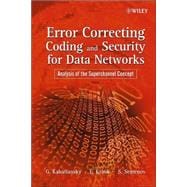
Note: Supplemental materials are not guaranteed with Rental or Used book purchases.
Purchase Benefits
What is included with this book?
Grigorii Kabatiansky is the author of Error Correcting Coding and Security for Data Networks: Analysis of the Superchannel Concept, published by Wiley.
Professor Evgenii Krouk has worked in the field of communication theory and techniques for more than 30 years. His areas of interests are coding theory, the mathematical theory of communications and cryptography. He is now the Dean of the Information Systems and Data Protection Faculty of the Saint-Petersburg State University of Aerospace Instrumentation. He is author of 3 books, more than 100 scientific articles and 30 international and Russian patents.
Sergei Semenov received his Ph.D. degree from St.-Petersburg State University for Airspace Instrumentation (SUAI), Russia in 1993. Dr. Semenov joined Nokia Corporation in 1999 and is currently a Specialist in Modem Algorithm Design/Wireless Modem. His research interests include coding and communication theory and their application to communication systems.
|
|||
|
|||
|
|||
|
|||
|
|||
|
|||
|
|||
|
|||
|
|||
|
|||
|
|||
|
|||
|
|||
|
|||
|
|||
|
|||
|
|||
|
|||
|
|||
|
|||
|
|||
|
|||
|
|||
|
|||
|
|||
|
|||
|
|||
|
|||
|
|||
|
|||
|
|||
|
|||
|
|||
|
|||
|
|||
|
|||
|
|||
|
|||
|
|||
|
|||
|
|||
|
|||
|
|||
|
|||
|
|||
|
|||
|
|||
|
|||
|
|||
|
|||
|
|||
|
|||
|
The New copy of this book will include any supplemental materials advertised. Please check the title of the book to determine if it should include any access cards, study guides, lab manuals, CDs, etc.
The Used, Rental and eBook copies of this book are not guaranteed to include any supplemental materials. Typically, only the book itself is included. This is true even if the title states it includes any access cards, study guides, lab manuals, CDs, etc.